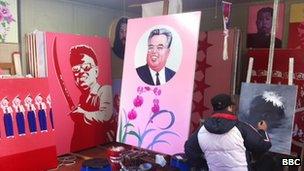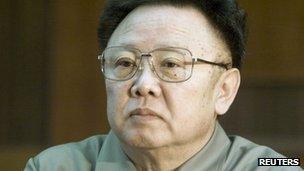Delving into North Korea's mystical cult of personality
- Published

Former state artist Sunmu says the contents of pictures were carefully dictated
Every night, North Korea's news bulletin begins with a song about the mythical qualities of the country's leader Kim Jong-il and the mountain where he is said to have been born.
North Koreans are used to the hyperbole of their state media, with a constant stream of stories about Kim Jong-il's economic guidance and benevolent care.
And since the death of the Dear Leader on 17 December, the media have focused their attention on a series of strange, natural phenomena being reported across the country - a giant lake of ice cracking in half, a red glow covering the mountain where their leader was born and, most recently, magpies gathering by the dozens in a single tree, in grief, according to one party official.
"We can't dismiss it as just a natural phenomenon," he told state television. "It shows that not only the people of the world, but the animals too, cannot forget our Dear Leader."
This is hardly surprising, perhaps, when his image - and that of his father Kim Il-sung - appears everywhere in billboards, buildings, television reports and every office wall.
Along with the army, North Korea's media apparatus is perhaps the institution most responsible for keeping its leaders in power.
It built powerful personality cults around both Kim Jong-il and his father and is now beginning to do the same with his son and successor, Kim Jong-un.
It is a myth-making factory that, for most of its audience, is their only source of news.
'Flowery language'
Brian Myers, professor of International Relations at Dongseo University in South Korea, has studied the archives of North Korean media reports closely.
He says this kind of imagery from the natural world has been seen before in other political systems.

North Korean media has used emotive language to encourage loyalty to Kim Jong-il
"There is the belief, which was common also in imperial Japan and Nazi Germany, that the actual physical territory occupied by the nation reflects the attributes of the race itself," he said.
"And this kind of flowery language that we've seen in the past few days, of ice cracking and cranes being seen in the sky, does reflect a uniquely North Korea understanding of a connection between the territory and the race."
And in the case of Kim Jong-il, he said, the media have spent years stirring up complex feelings in the minds of people.
"Kim Jong-il's official image in the propaganda was always a man with no time for himself, and a large part of the propaganda was aimed at making the public feel guilty about the overwork that he was subjecting himself to, Mr Myers said.
"And I think these feelings of guilt are a part of the whole mourning ceremony now."
'Taboo' art
Sunmu, a former North Korean state artist now living here in Seoul, used to be part of that propaganda machine. He remembers working under North Korea's first leader, Kim Il-sung.
The media machine was so tightly-controlled, he said, that only a handful of people were allowed to draw the leader himself.
"All the directives of what the picture should be about, and how it should be drawn came down from higher up and all I needed to do was follow them," Sunmu said.
"I wanted to draw Kim Il-sung himself but only a few designated artists were allowed to. So I would lock myself into a room to draw Kim Il-sung and then burn it. Even my parents could not know I'd done that."
Sunmu said he would have ended up in a political prison camp "or maybe even executed" if anyone had found out about his drawing.
But the urge to draw him was so strong because it was "taboo" for ordinary artists to do so.
This time around, he said, the North Korean media appear to be focusing more on the "Great Successor", Kim Jong-il's youngest son and the country's presumed new leader.
Kim Jong-un is a man in his 20s who already looks strikingly like his grandfather, who is North Korea's eternal president.
Untried and untested, he will perhaps depend even more on the power of his lineage, and the personality cult created by his country's unique cultural machine.